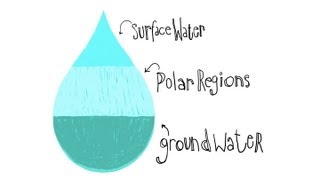(单词翻译:单击)
At birth, our bodies are roughly 75% water.
在出生时,我们身体里约75%是水。
We remain mostly water for the rest of our lives.
在我们这一生中,身体中的水分也大多维持这个比例。
We cannot survive even a week without fresh water.
如果没有淡水,我们活不过一周。
There's no life without it for ecosystems, societies, and individuals.
没有淡水,生命将不复存在,对生态系统、社会以及个人都是如此。
So, how much usable water is there on Earth?
那么,地球上究竟有多少可用淡水呢?
Most of the water on Earth is ocean, a salty 97.5%, to be precise, and the remaining 2.5% is fresh water.
地球上大部分的水都是含盐的海水,具体比例为97.5%,剩下的2.5%才是淡水。
That little sliver of liquid sustains human life on Earth, it literally holds up civilizations.
这一点点淡水维持着地球上人类的生命,从本质上讲,是它支撑着我们的文明。
2.5% is a small proportion to be sure, and even that is broken down into smaller parts:
毫无疑问,2.5%是个很小的比例,但即便如此,淡水还能分成更小的几类:
surface water, water in ice caps and polar regions, and ground water.
地表水、存在于冰盖和极地地区的水以及地下水。
First, surface water. All the liquid water above ground is surface water and it is a tiny blip of an amount.
首先说一下地表水。所有在地表上的液态水都是地表水,但这仅占所有水资源的一小部分。
0.3% of all fresh water is surface water.
0.3%的淡水是地表水。
It may seem counterintuitive, but it accounts for little streams all over the planet.
这或许和我们想象的不同,不过这已包含了地球上所有的溪流。
All rivers, including the Nile, the Jordan, and the Mississippi,
所有的河流,包含尼罗河、约旦河和密西西比河,
and lakes, large to small, like Victoria, the Great Lakes, and Baikal.
以及大大小小的湖泊:像是维多利亚湖、五大湖和贝加尔湖。
Second, ice caps and polar regions freeze up to 70% of the planet's fresh water.
再者,冰盖和极区冰封了地球上70%的淡水。
This water is significant, but it isn't available for human use in a regular way.
这种水很重要,但却无法供人类以常规方式使用。
Finally, nearly 30% of all water on Earth is ground water.
最后,地球上将近30%的淡水是地下水。
As the name suggests, that's water in the ground.
就如同其名字所示,这部分的水是存在地底下的。
It can rest still and deep in huge caverns, or it can snuggle in the little crevices of rock and pebble.
它可能是静止地存在巨大洞穴的深处,也可能是潜藏于岩石裂隙和卵石的缝隙之间。
The upshot - thank goodness for ground water!
总归一句话:感谢上天给我们地下水!

It's invisible to us, but it is much more plentiful than surface water.
虽然我们看不见地下水,但它比地表水更为丰沛。
It is much more reliable and easier to obtain than frozen water.
地下水也比冻结的水体更可靠,也更容易取得。
Without ground water, our societies would be parched. So, how are we using that water?
如果没有地下水,我们的社会将会枯萎。那我们又是如何运用水资源的呢?
As a result of industrialization and population growth, demand for fresh water skyrocketed in the last century.
因为工业化和人口增长,自上世纪起我们对于淡水的需求暴增。
Where is all that water going?
而这些水又被用在哪些地方呢?
First, we have to remember that fresh water is a global concern, but it is always local.
首先,我们必须记住,淡水虽攸关整个世界,但永远具有区域性。
Context matters. The Sahara is not Seattle.
也就是说,萨哈拉并非西雅图。
Still, some general information can help us get a handle on major trends.
还有一些概念可以帮助我们理解整体趋势。
Who consumes the most fresh water?
谁消耗了大部分的淡水呢?
And, what sectors consume the most fresh water? First, who.
哪些区域使用最多的淡水呢?我们先说说是谁。
Well, the United States consumes the most water per capita of any country in the entire world,
在整个世界的所有国家中,美国使用了最多的水资源,
followed by parts of Europe and large industrializing nations like China.
紧接着是部分欧洲国家和像中国这样的大型工业化国家。
But, this doesn't tell us what water is being used for. So let's look at it another way.
但是这并不能告诉我们水被运用在那些方面。所以就让我们换种角度吧。
If we ask what kinds of uses water is going towards, we see a different picture.
如果我们探讨水的用途,我们将会看到不同的结果。
Agriculture accounts for roughly 70% of global fresh water consumption.
农业用水大约占全世界水资源消耗的70%。
Again, remember the numbers vary by region, but still, it's a staggering amount.
虽说数据会因地区而不同,但这仍是个惊人的用量。
And, this makes a certain kind of sense: we need to eat, we need water to grow food;
然而,这也很合理:我们需要吃饭,所以我们需要用水来种植粮食;
the bigger the population, the more food we need;
人口越多,我们所须要的食物也越多;
and, the wealthier we get, the more meat we eat, and the more water is required to produce our food.
而且,我们越富有,我们就会食用更多肉类食品,导致我们需要将更多的水用于生产食物上。
Furthermore, 22% of all fresh water worldwide goes to industrial uses.
再者,世界上22%的淡水用在了工业生产上。
This includes the production of electricity, the extraction of fossil fuels,
这里包含了生产电力、提炼石化燃料
and the manufacturing of all manner of goods, from microchips, to paper, to blimps.
以及生产各式产品,从芯片到纸张再到飞船。
70% to agriculture, 22% to industrial uses, what's left? 8%
70%用在农业,22%用在工业,其余的是多少?8%。
All those domestic uses - cooking, cleaning, bathing, drinking - it's a drop in the bucket of overall water use.
煮饭、清洁、洗澡、饮用--所有这些家庭生活方面的使用--这在整体的水资源使用上可以说是微不足道。


